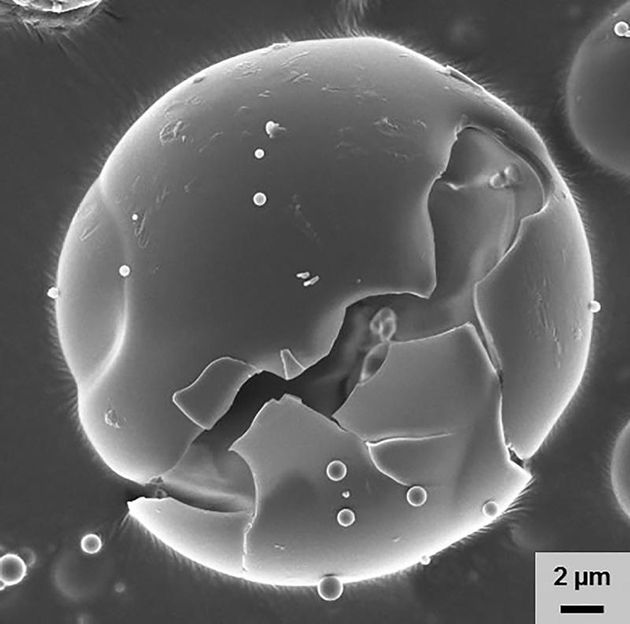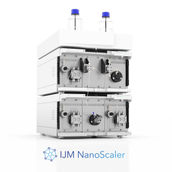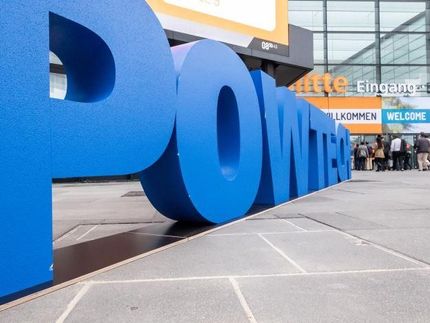Spray drying: Perfect dosing thanks to drug capsules
Instant coffee and powdered milk are produced by spray drying. Fraunhofer researchers have adapted this technique to the tricky question of incorporating insoluble substances in core-shell particles. The new method helps reduce the concentration of active ingredients in therapeutic medications.

Core-shell particle
© Fraunhofer IGB
Encapsulation is used in cosmetics and pharmaceuticals to protect active ingredients against external influences such as aggressive gastric acid. Another use of encapsulation is to control the release of active ingredients inside the body: depending on the permeability of the shell material, the medication is delivered gradually rather than all at once. Because such systems release multiple, smaller doses over an extended period of time, the drug therapy is better tolerated and easier to administer. In some cases, it means taking just one pill a day instead of three.
Insoluble substances are a problem
The first step of the encapsulation process involves dissolving the active ingredient in a liquid medium and mixing it with the shell material. Then the solution is piped to an orifice in the center of a nozzle surrounded by an annular channel through which compressed air is injected at high speed. The pressure disperses the solution into an aerosol of fine droplets, which is then sprayed into a drying cylinder. Here, the liquid evaporates, leaving behind a fine powder of core-shell particles. The problem is that it is difficult to mix insoluble substances with other materials. This limits the choice of shell materials that can be used to produce the particles.
Three-way nozzle permits endless combinations of materials
“For this reason, we use a three-way nozzle to implement spraying. Its advantage is that it permits two substances to be fed separately to the nozzle. The shear forces mix the substances together at the orifice of the nozzle, creating an aerosol containing both materials,” explains Michael Walz, who developed and optimized the new technique with his colleague Dr. Achim Weber at the Fraunhofer Institute for Interfacial Engineering and Biotechnology IGB in Stuttgart.
This system permits endless combinations of materials, enabling the controlled release of active ingredients to be adapted to different applications. “We can modify the particle size and encapsulation efficiency by selecting the appropriate substances and by varying the concentration of the solution, the liquid volume flow, the drying temperature, and the pressure applied to the nozzle. This gives us the capability to respond to almost any customer requirement and develop solutions tailored to their needs,” says Weber.
The new process for the encapsulation of active ingredients could be of interest to fertilizer manufacturers and food processing companies as well as the cosmetics and pharmaceutical industries.
Most read news
Topics
Organizations
Other news from the department science
These products might interest you

Pharmaceutical Substances by Thieme Verlag
Look up Industrial Syntheses of 2,600 APIs
Your tool for Syntheses, Patents and Applications – Pharmaceutical Substances

KNAUER IJM NanoScaler by KNAUER
Efficient formulation of lipid nanoparticles for RNA-based therapies
Optimise drug encapsulation from 1 ml to hundreds of millilitres with minimal drug input

Get the life science industry in your inbox
By submitting this form you agree that LUMITOS AG will send you the newsletter(s) selected above by email. Your data will not be passed on to third parties. Your data will be stored and processed in accordance with our data protection regulations. LUMITOS may contact you by email for the purpose of advertising or market and opinion surveys. You can revoke your consent at any time without giving reasons to LUMITOS AG, Ernst-Augustin-Str. 2, 12489 Berlin, Germany or by e-mail at revoke@lumitos.com with effect for the future. In addition, each email contains a link to unsubscribe from the corresponding newsletter.





















































